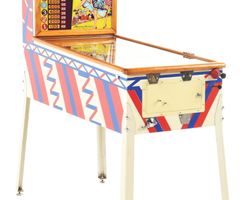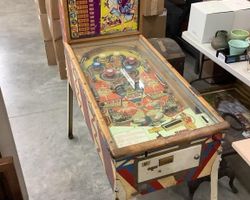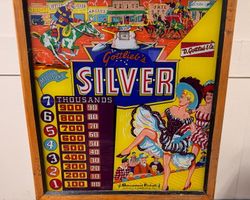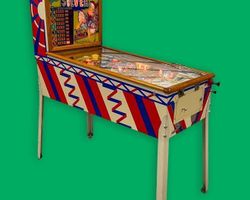Silver
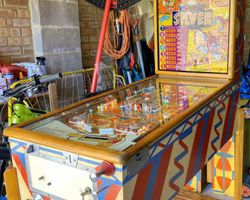
Average Prices: USD $500 to $1,300
Produced: October, 1957
Production Run: 2,150 units
Machine Type: Electro-mechanical
Players: 1
Design by: Wayne Neyens
Art by: Roy Parker
"Silver" by Gottlieb stands as a testament to an era when pinball machines were rapidly evolving, captivating players with their mechanical ingenuity and vibrant aesthetics. Introduced in October 1957, this electro-mechanical (EM) game, model number 139, emerged from the prolific Gottlieb factory, a company already a dominant force in the amusement industry. The machine's production run of 2,150 units positioned it as a significant release of its time.
The design of "Silver" was spearheaded by Wayne Neyens, a designer known for his intuitive playfield layouts and engaging gameplay experiences. Neyens’s approach often emphasized fluid ball movement and clear objectives, principles evident in "Silver." The visual identity of the machine, from its playfield to its backglass, was crafted by Roy Parker, an artist whose distinctive style brought characters and themes to life through bold lines and rich colors. For "Silver," Parker leaned into an American West theme, a popular motif that evoked adventure and frontier spirit, perfectly aligning with the aspirations and cultural backdrop of the late 1950s. The backglass, a canvas for Parker's work, famously bore Gottlieb's slogan: "Amusement Pinballs, as American as Baseball and Hot Dogs!" This phrase underscored the game's place in popular culture, framing pinball as a wholesome, integral part of American leisure. An interesting production detail for "Silver" is the 'S' suffix on all its serial numbers, specifically denoting the "Silver" model, a practice distinct from the marking of sample games during that period.
Mechanical Artistry and Thematic Elements
"Silver" distinguishes itself with a blend of classic EM features and specific design choices that enhance its allure. The game includes two flippers, positioned to provide precise shot control, accompanied by four pop bumpers that inject chaotic energy into gameplay as the ball careens off them. Two passive bumpers and two slingshots further contribute to the dynamic ricochet action across the lower playfield. Two bullseye targets offer direct scoring opportunities, requiring accuracy to hit. A pair of gobble holes, strategically placed, offer high-value rewards or special bonuses, adding an element of risk and reward to specific shots. Two rollover buttons present further scoring paths, often leading to progressive lighting features.
A notable mechanical feature is the roto-target, an element that rotates or shifts, presenting varying targets or scoring opportunities depending on its current state. This adds a layer of unpredictability and strategy, as players must adapt their shots to the target's position. Beyond the direct gameplay elements, "Silver" includes an intriguing period-specific detail: metal cigarette holders integrated into the side woodrails. While a minor addition, it provides a glimpse into the social context of public amusement venues of the era. The integration of these features, from the responsive flippers to the unpredictable roto-target, creates a tactile and engaging experience that defines the machine's interactive design and appeals to players seeking both skill and chance.
The Playfield's Panoramic Challenge
The playfield of "Silver" is a carefully orchestrated landscape, designed to guide the player's eye and the ball’s path through a series of targets and features. The layout adheres to a philosophy of clear shot objectives within a relatively open space, characteristic of many Gottliebs of the period. The two main flippers anchor the lower playfield, providing the primary means of ball control and shot execution. Above them, the slingshots deflect the ball with force towards the center, often into the bustling activity of the pop bumpers positioned higher up. These four pop bumpers are arranged to create a high-energy zone, where the ball gains speed and direction before cascading down the playfield.
The upper portion of the playfield houses the two bullseye targets and the roto-target, inviting precise shots. The bullseye targets provide immediate points and contribute to specific game objectives. The roto-target, with its shifting nature, demands adaptive aiming, presenting different scoring opportunities as it changes orientation. The two gobble holes are strategically placed, often requiring skillful, controlled shots to enter, rewarding players with significant points or special awards. Interspersed throughout the playfield are two rollover buttons, which, when activated by the ball, progress specific lighting features. Roy Parker’s artwork envelops this mechanical landscape with its American West theme. Imagery of cowboys, horses, and frontier towns creates a cohesive visual narrative. The lighting, though simpler than modern machines, effectively highlights scoring opportunities and guides the player's focus to active areas, enhancing the overall aesthetic and contributing to player immersion without overwhelming the visual field.
Engaging Gameplay Dynamics and Scoring
Gameplay on "Silver" revolves around a clear progression of objectives aimed at accumulating points and earning replays. The scoring system is straightforward yet provides ample opportunity for high scores, with the maximum displayed point score capped at 7,990,000 points. Players begin by aiming for various targets to light up features and build their score. The bullseye targets and rollover buttons contribute foundational points, setting the stage for more advanced play.
One of the defining gameplay mechanics is the "hold over special for lighting the name SILVER." This feature encourages players to systematically hit targets or complete sequences to illuminate each letter in the word "SILVER" on the backglass or playfield. Successfully lighting all letters typically awards a special, a highly coveted bonus that often translates into a replay or an extra ball, driving players to continue their pursuit. The gobble holes also play a crucial role, often designated as "gobble hole specials." Sinking the ball into these holes can immediately trigger high-value points or award replays, making them risky but rewarding targets.
The interplay of these features creates a dynamic loop: players attempt to light "SILVER" for a special, while also seeking out the immediate gratification of gobble hole specials and accumulating points from pop bumpers and other targets. This balanced design makes "Silver" highly repeatable. The replay wheel, capable of awarding up to 26 replays, further incentivizes extended play sessions, allowing skilled players to continue their game for significant periods. The tilt penalty, resulting in a game over, maintains a sense of challenge, punishing overly aggressive nudging and encouraging precise control. This blend of accessible objectives, progressive rewards, and a clear path to replays ensured "Silver" offered a compelling gameplay experience that kept players returning to the machine.
Enduring Appeal and Community Standing
"Silver" by Gottlieb has garnered an overwhelmingly positive reception within the pinball community, cementing its status as a highly regarded electro-mechanical machine from the 1950s. Enthusiasts frequently laud it as one of Gottlieb's finest outputs from that decade, often mentioning it in the same breath as other celebrated titles like "Roto Pool," "Royal Flush," "Ace High," and "Dragonette." Its strengths lie in its consistently enjoyable gameplay and remarkable replayability. Players often highlight the ease with which one can achieve high scores and earn replays, making it accessible even to those less familiar with older EM machines, while still offering depth for experienced players. This accessibility, particularly the "hold over special for lighting the name SILVER," is frequently cited as a major draw, providing a clear and rewarding objective that encourages continued engagement.
The machine's enduring appeal is also rooted in nostalgia. Many collectors and players recount fond memories of encountering "Silver" in their youth, leading them to seek out and restore units today, preserving them for future generations. This deep personal connection often translates into a high perceived value, with "Silver" commanding a premium price in the market, even over machines with lower production numbers. This willingness to invest reflects its desirability and the community's high regard for its quality and design.
While the sentiment is largely positive, the primary 'weaknesses' cited are inherent to the nature of vintage electro-mechanical machines: maintenance and restoration needs. Owners often note that older units may not perform optimally without proper attention. Achieving peak play on "Silver" can involve adjustments to the playfield slope, fine-tuning flipper angles, ensuring correct voltage from power transformers, and calibrating coils. However, these points are often framed not as flaws, but as opportunities for owners to bring the machine back to a condition that often surpasses its original factory performance. The legacy of "Silver" is not merely its status as a collectible; it lies in its role as a benchmark for well-designed EM games. Its blend of engaging mechanics, satisfying scoring, and charming artwork solidified its reputation as a classic, influencing the ongoing appreciation for the simplicity and mechanical elegance of the electro-mechanical era in pinball history.
Sponsored Links
 Ebay Listings
Ebay Listings
 Auction Results
Auction Results
| Cost | Location | Date |
|---|---|---|
| USD $800 |  Massachusetts, United States Massachusetts, United States |
17 April, 2025 |
| USD $1,700 |  Arizona, United States Arizona, United States |
15 October, 2024 |
| USD $850 |  Ohio, United States Ohio, United States |
12 September, 2024 |
| USD $650 |  Nevada, United States Nevada, United States |
13 April, 2024 |
| USD $135 |  Iowa, United States Iowa, United States |
28 November, 2021 |
| GBP £1,100 |  Penarth, United Kingdom Penarth, United Kingdom |
28 May, 2020 |
| USD $1,300 |  Indiana, United States Indiana, United States |
06 July, 2017 |
| USD $350 |  Georgia, United States Georgia, United States |
16 May, 2015 |
| USD $1,500 |  Maryland, United States Maryland, United States |
02 February, 2011 |
| USD $1,275 |  California, United States California, United States |
21 August, 2010 |


Private Policy · Search Website · Contact Us
As an eBay Partner, we may earn a commission from qualifying purchases made through links on this site, at no additional cost to you.
All trademarks and copyrighted materials remain property of their respective owners. All other content copyright 2007 - 2025 Pinpedia.

